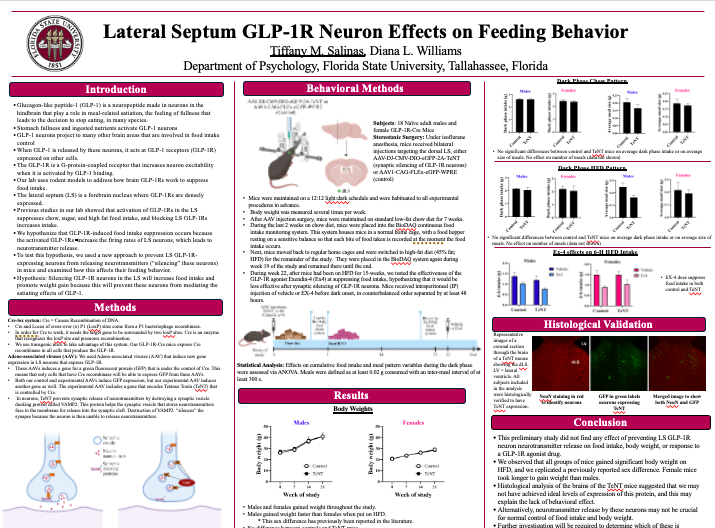Research Symposium
24th annual Undergraduate Research Symposium, April 3, 2024
Tiffany Salinas Poster Session 3: 1:30 pm - 2:30 pm /452

BIO
Hi, my name is Tiffany Salinas and I am from Miami, Florida. Early on in my undergraduate career, the mind, specifically, the brain fascinated me and uncovering its mysteries was a goal I was set on doing. I plan on going to graduate school to pursue my PHD in neuroscience. FSU, being a prestigious research institution, has provided me with opportunities to explore my career passion. From zebra finches, to mice, to humans, I have been a part of different labs gaining skills, building connections with professors and grad students, and exploring the different aspects of what it means to be a research scientist.
Lateral Septum GLP-1R Neuron Effects on Feeding Behavior
Authors: Tiffany Salinas, Diana WilliamsStudent Major: Psychology
Mentor: Diana Williams
Mentor's Department: Psychology Mentor's College: Arts and Sciences Co-Presenters:
Abstract
Glucagon-like peptide 1 (GLP-1) is a neuropeptide made in neurons in the hindbrain that project to many other brain areas. GLP-1 act at its excitatory G-protein coupled receptor (the GLP-1R) expressed throughout the brain to suppress food intake. We focused on the lateral septum (LS), which contributes to feeding behavior. We have shown that injection of GLP-1R agonists into the LS reduces chow, sugar, and high fat food intake, and blocking GLP-1Rs increases intake. To further investigate how GLP-1R effects are mediated, we used a virally-mediated synaptic silencing approach to prevent GLP-1R-expressing neurons in the LS from releasing neurotransmitter. This involves injection of an adeno-associated virus to manipulate gene expression in transgenic mice. One group received intra-LS injection of the silencing virus (n = 6 female, 4 male) and a control group was injected with a control virus (n = 3 female, 4 male). We hypothesized that silencing GLP-1R neurons in the LS would increase food intake and promote weight gain because this would prevent these neurons from mediating the satiating effects of GLP-1. After AAV injection, body weights and food intake on chow and then high-fat diet were monitored. There were no significant differences between groups for body weight, food intake, or meal patterns, but mice did gain significant body weight on HFD. We also observed that the GLP-1R agonist Exendin-4 was still able to suppress food intake in these mice. Neurotransmitter release by these neurons may not be crucial for normal control of food intake and body weight.
Keywords: Feeding, GLP-1R, Mice


